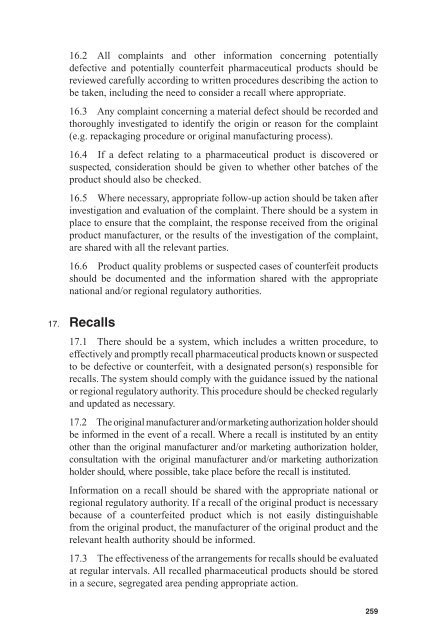Annex 5 WHO good distribution practices for pharmaceutical products
Annex 5 WHO good distribution practices for pharmaceutical products
Annex 5 WHO good distribution practices for pharmaceutical products
Create successful ePaper yourself
Turn your PDF publications into a flip-book with our unique Google optimized e-Paper software.
16.2 All complaints and other in<strong>for</strong>mation concerning potentiallydefective and potentially counterfeit <strong>pharmaceutical</strong> <strong>products</strong> should bereviewed carefully according to written procedures describing the action tobe taken, including the need to consider a recall where appropriate.16.3 Any complaint concerning a material defect should be recorded andthoroughly investigated to identify the origin or reason <strong>for</strong> the complaint(e.g. repackaging procedure or original manufacturing process).16.4 If a defect relating to a <strong>pharmaceutical</strong> product is discovered orsuspected, consideration should be given to whether other batches of theproduct should also be checked.16.5 Where necessary, appropriate follow-up action should be taken afterinvestigation and evaluation of the complaint. There should be a system inplace to ensure that the complaint, the response received from the originalproduct manufacturer, or the results of the investigation of the complaint,are shared with all the relevant parties.16.6 Product quality problems or suspected cases of counterfeit <strong>products</strong>should be documented and the in<strong>for</strong>mation shared with the appropriatenational and/or regional regulatory authorities.17. Recalls17.1 There should be a system, which includes a written procedure, toeffectively and promptly recall <strong>pharmaceutical</strong> <strong>products</strong> known or suspectedto be defective or counterfeit, with a designated person(s) responsible <strong>for</strong>recalls. The system should comply with the guidance issued by the nationalor regional regulatory authority. This procedure should be checked regularlyand updated as necessary.17.2 The original manufacturer and/or marketing authorization holder shouldbe in<strong>for</strong>med in the event of a recall. Where a recall is instituted by an entityother than the original manufacturer and/or marketing authorization holder,consultation with the original manufacturer and/or marketing authorizationholder should, where possible, take place be<strong>for</strong>e the recall is instituted.In<strong>for</strong>mation on a recall should be shared with the appropriate national orregional regulatory authority. If a recall of the original product is necessarybecause of a counterfeited product which is not easily distinguishablefrom the original product, the manufacturer of the original product and therelevant health authority should be in<strong>for</strong>med.17.3 The effectiveness of the arrangements <strong>for</strong> recalls should be evaluatedat regular intervals. All recalled <strong>pharmaceutical</strong> <strong>products</strong> should be storedin a secure, segregated area pending appropriate action.259
















